Clarissa Wei’s Taiwanese Steamed Preserved Greens and Pork
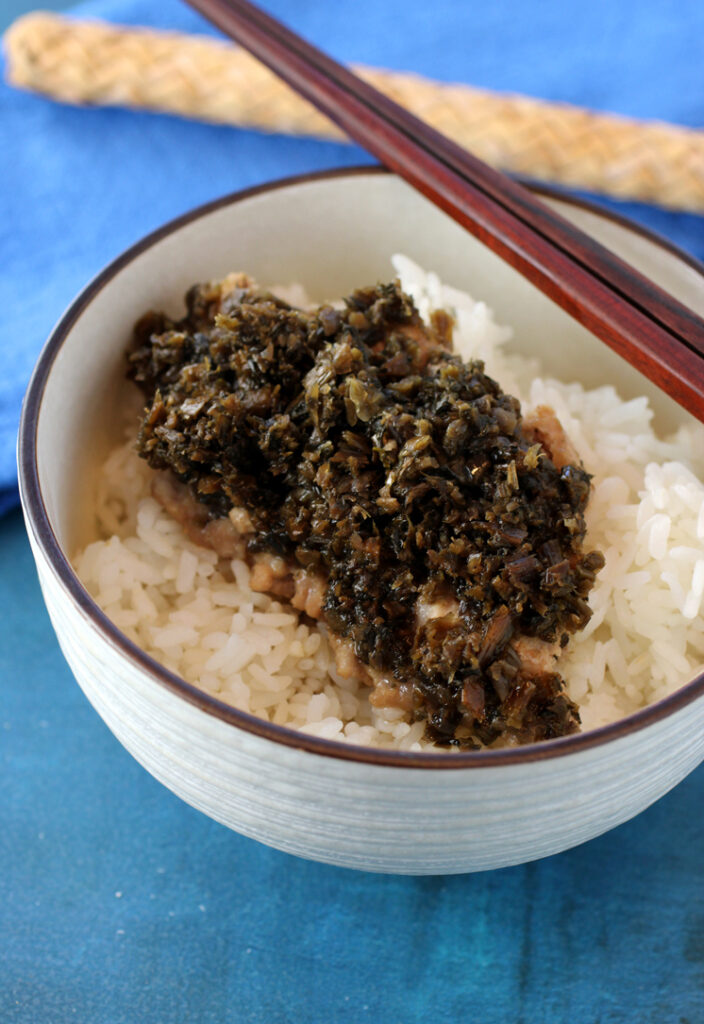
For many people, their idea of pure comfort food involves sinking their teeth into a juicy grilled meat patty.
Not me.
Instead, I find the ultimate contentment in a tender meat patty that’s steamed.
The kind that emerges from a bamboo steamer in its own deep pool of delectable juices and flavorings all beautifully co-mingled, and just begging to be spooned over a bowl of steamed white rice.
“Steamed Preserved Greens and Pork” is that kind of dish. It’s from “Made In Taiwan” (Simon Element, 2023) of which I received a review copy.
This beautiful, acclaimed book is the work of Clarissa Wei, a Taipei-based food journalist who has been writing about the cuisines and cultures of Taiwan and China for more than 10 years.
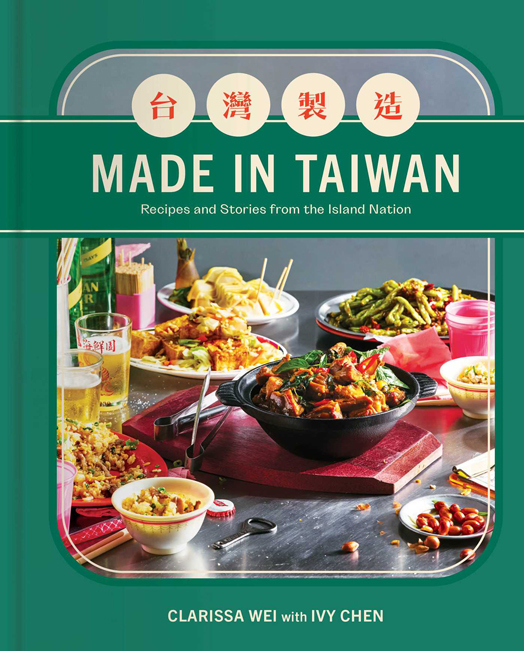
While Taiwanese cooking has often been lumped under the all-encompassing umbrella of “Chinese food,” Wei takes pains to give this fiercely independent island nation of 23.5 million people its culinary due. When she describes Taiwan as being shaped “like a sweet potato — curvy and fat in the middle, gently tapered off at the ends,” you know you are in for a mouthwatering time, as well as a captivating read.
Along with a history lesson, there’s a primer on pantry ingredients including Taiwanese soy paste, a Taiwanese condiment that’s made with soy sauce, sugar and glutinous rice flour that resembles Chinese oyster sauce.
Get a taste of this proud country in recipes such as delicate “Taiwanese Egg Crepe,” brothy “Peddler Noodles” (with braised minced pork belly and shrimp), “Taiwanese Tempura” (fish and pork back fat pulverized in a food processor, then deep fried), and “Tapioca Pearl Milk Tea.”
Steamed pork patties or cakes have a soft spot in my heart because my mom used to make them regularly. She’d enfold the ground pork with ginger, soy sauce, and shiitake mushrooms, sometimes adding water chestnuts for a surprise of crunchiness or chopped pieces of liver for an earthy depth or salted fish for an addictive savoriness that leaves you smacking your lips in delight.
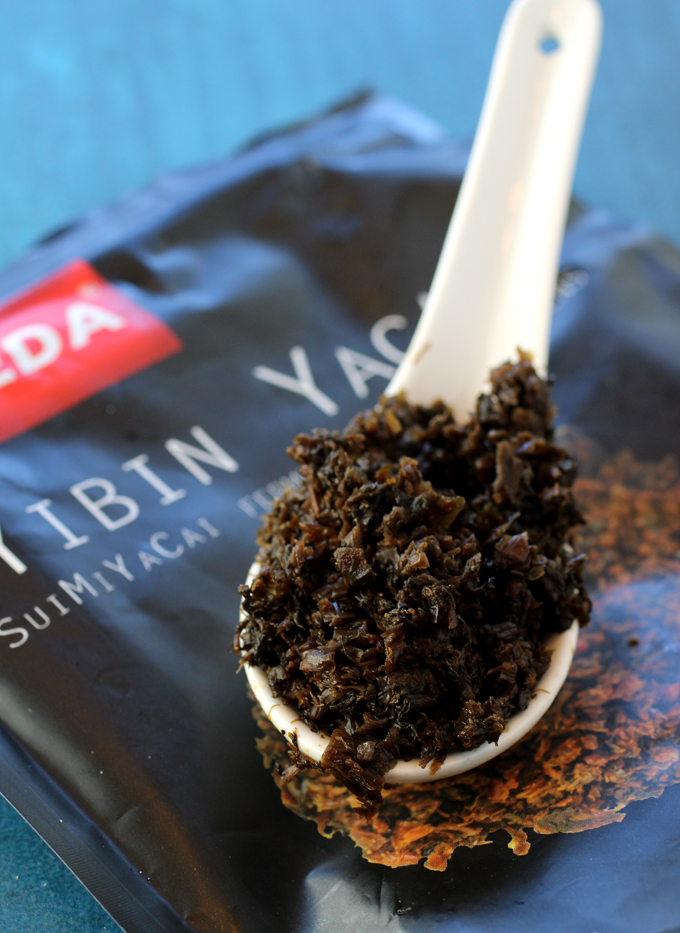
She never added preserved mustard greens, but I think she would have much appreciated Wei’s version that does.
Preserved mustard greens can be found in packages in Asian markets. They are the stems of mustard greens that have been dried, fermented in salted water, boiled with brown sugar, then fermented again with other spices such as clove, garlic, and nutmeg. If you make your own, you probably leave the stems in large pieces. However, if you opt for store-bought, you’ll find them already finely shredded. This condiment is an umami bomb with a little saltiness along with an earthy-funky fermented quality that gives it a long finish on the palate. Some people liken it to a Chinese version of sauerkraut. To me, it is very reminiscent of the taste of Chinese fermented black beans.
This is one of those no-brainer dishes that comes together quickly with a mere handful of ingredients, making it ideal even when you’re exhausted after work and want to get dinner on the table quickly.
The most time consuming step is simply soaking the preserved mustard greens in water for 1 hour, which will leech out some of its salt. If you’re pressed for time, 30 minutes will suffice. Wei instructs to dry the mustard greens afterward, then mince finely. If your preserved mustard greens already came minced, you can skip any further mincing.
From there, it’s just a matter of seasoning ground pork with soy sauce and salt, then mixing in a little cornstarch.

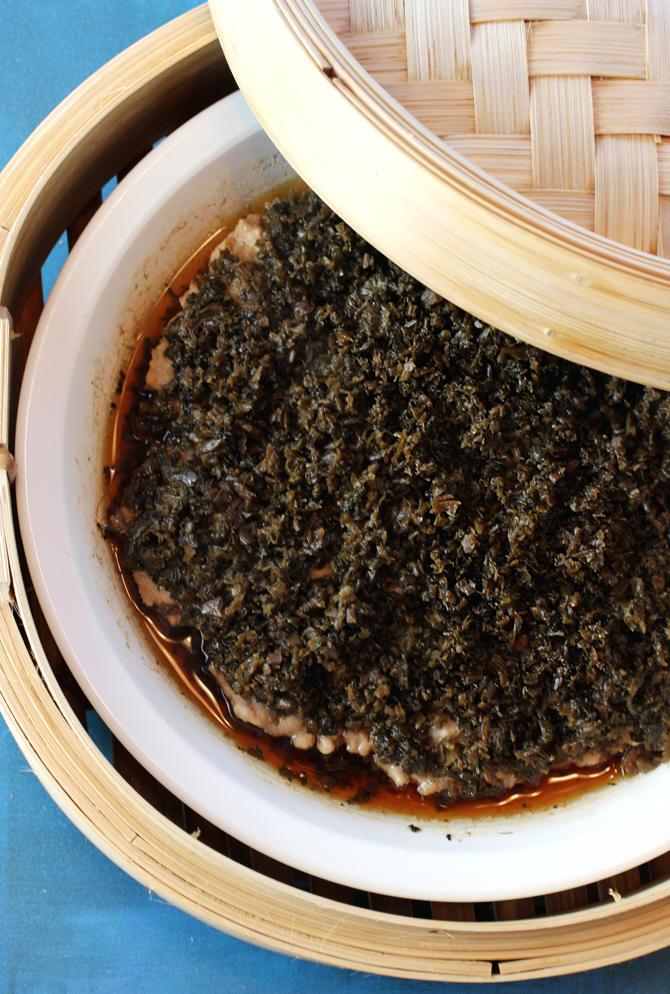
Pat the pork mixture into a heat-proof dish. A glass or ceramic pie plate works really well for this. Then, scatter the preserved mustard greens all over the top.
Place the dish into your steamer, cover, and steam for 20 minutes.
The pork will end up tender and juicy, with a deep savoriness and a pleasing fermented note.
Serve with plenty of rice, of course, to soak up all those meaty juices, and perhaps some stir-fried greens.
Try it and you’ll see why it gives the all-American burger a run for its money — at least in my book.
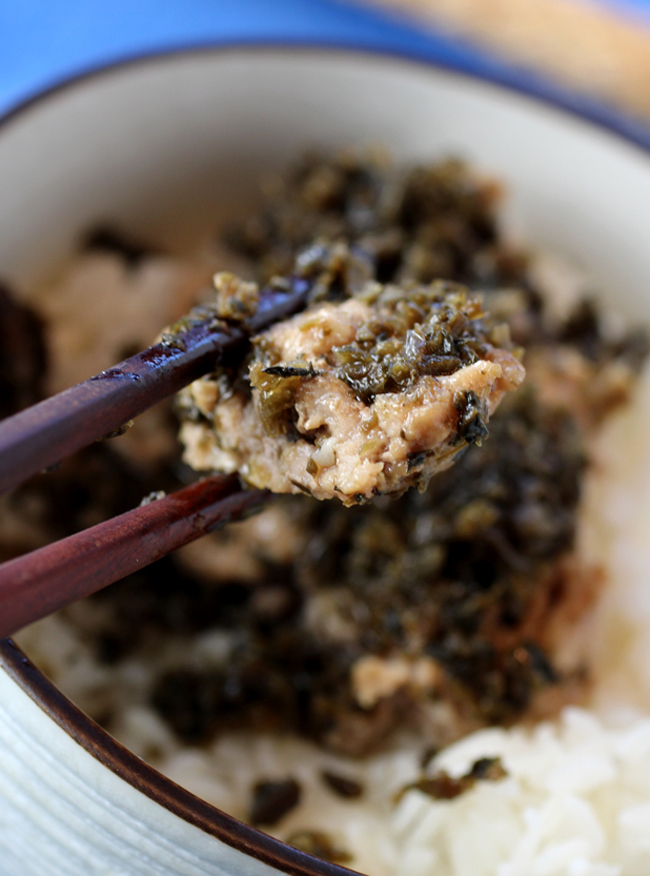
Steamed Preserved Greens and Pork
(Serves 3)
1/2 cup dried salted preserved mustard greens (store-bought or homemade)
1 pound coarsely ground pork
1 tablespoon tapioca starch or cornstarch
1 teaspoon soy sauce (optional)
1 teaspoon fine sea salt
In a small bowl, soak the preserved mustard greens in room-temperature water for 1 hour. (Half an hour will suffice if you’re in a hurry.) Rinse the greens thoroughly under running water to get rid of any dirt or grit. Pat dry with paper towels or run through a salad spinner to dry (if your greens are in large pieces). Mince the greens finely (if they are not already minced).
In a heatproof medium bowl, combine the ground pork, tapioca starch, soy sauce (if using), and salt, and quickly massage the seasoning into the meat, about 10 seconds. Put the dried mustard greens on top. Or alternatively, you can massage the greens directly into the ground pork before steaming. Transfer the bowl to a steamer, and cover.
Partially fill a large wok with water. Bring the water to a rapid boil over medium heat and place the steamer on top. Steam for 20 minutes. Enjoy immediately.
Adapted from “Made in Taiwan” by Clarissa Wei

More: My Steamed Pork Cake Inspired by My Mom’s

And Another Recipe Using Preserved Mustard Greens: Jon Kung’s Dan Dan Lasagna

Can I use fresh mustard greens? What additional seasoning would you suggest if I wanted to use fresh greens? Thanks in advance!
Hi Reuel: Fresh mustard greens would definitely deliver a different flavor profile. Think of it as like fresh cabbage versus sauerkraut. Both are delicious, but vastly different in flavor. The former is mild; the latter is definitely more assertive. With preserved mustard greens, you get a much deeper taste. You could try making your own, but it is a process, not unlike making kimchi. So, picking up a bag at an Asian market or via Amazon is definitely an easier way to go. Enjoy!